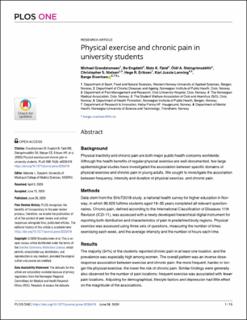| dc.contributor.author | Grasdalsmoen, Michael | |
| dc.contributor.author | Engdahl, Bo Lars | |
| dc.contributor.author | Fjeld, Mats Kirkeby | |
| dc.contributor.author | Steingrímsdóttir, Ólöf Anna | |
| dc.contributor.author | Nielsen, Christopher Sivert | |
| dc.contributor.author | Eriksen, Hege Randi | |
| dc.contributor.author | Lønning, Kari Jussie | |
| dc.contributor.author | Sivertsen, Børge | |
| dc.date.accessioned | 2020-09-07T06:56:30Z | |
| dc.date.available | 2020-09-07T06:56:30Z | |
| dc.date.created | 2020-06-29T12:17:22Z | |
| dc.date.issued | 2020 | |
| dc.identifier.issn | 1932-6203 | |
| dc.identifier.uri | https://hdl.handle.net/11250/2676515 | |
| dc.description.abstract | Background
Physical inactivity and chronic pain are both major public health concerns worldwide. Although the health benefits of regular physical exercise are well-documented, few large epidemiological studies have investigated the association between specific domains of physical exercise and chronic pain in young adults. We sought to investigate the association between frequency, intensity and duration of physical exercise, and chronic pain.
Methods
Data stem from the SHoT2018-study, a national health survey for higher education in Norway, in which 36,625 fulltime students aged 18–35 years completed all relevant questionnaires. Chronic pain, defined according to the International Classification of Diseases 11th Revision (ICD-11), was assessed with a newly developed hierarchical digital instrument for reporting both distribution and characteristics of pain in predefined body regions. Physical exercise was assessed using three sets of questions, measuring the number of times exercising each week, and the average intensity and the number of hours each time.
Results
The majority (54%) of the students reported chronic pain in at least one location, and the prevalence was especially high among women. The overall pattern was an inverse dose-response association between exercise and chronic pain: the more frequent, harder or longer the physical exercise, the lower the risk of chronic pain. Similar findings were generally also observed for the number of pain locations: frequent exercise was associated with fewer pain locations. Adjusting for demographical, lifestyle factors and depression had little effect on the magnitude of the associations.
Conclusion
Given the many health benefits of regular exercise, there is much to be gained in facilitating college and university students to be more physically active, ideally, thru a joint responsibility between political and educational institutions. Due to the cross-sectional nature of the study, one should be careful to draw a firm conclusion about the direction of causality. | en_US |
| dc.language.iso | eng | en_US |
| dc.publisher | Public Library of Science | en_US |
| dc.rights | Navngivelse 4.0 Internasjonal | * |
| dc.rights.uri | http://creativecommons.org/licenses/by/4.0/deed.no | * |
| dc.title | Physical exercise and chronic pain in university students | en_US |
| dc.type | Peer reviewed | en_US |
| dc.type | Journal article | en_US |
| dc.description.version | publishedVersion | en_US |
| dc.source.journal | PLOS ONE | en_US |
| dc.identifier.doi | 10.1371/journal.pone.0235419 | |
| dc.identifier.cristin | 1817541 | |
| dc.description.localcode | Copyright: © 2020 Grasdalsmoen et al. This is an open access article distributed under the terms of the Creative Commons Attribution License, which permits unrestricted use, distribution, and reproduction in any medium, provided the original author and source are credited | en_US |
| cristin.ispublished | true | |
| cristin.fulltext | original | |
| cristin.qualitycode | 1 | |

